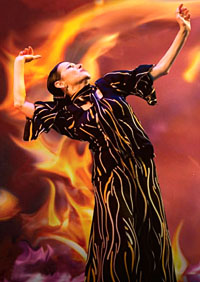Dark Night of the Soul: Change at Zorongo
Camille LeFevre reviews the last performance Susana DiPalma will give as a principal dancer with her ensemble, Zorongo Flamenco. It's worthy.

Several weeks before the premiere of “Noche Oscura (Dark Night),” Zorongo Flamenco Dance Theatre’s new work, artistic director Susana di Palma called with startling news: The show would mark her final performance as her company’s lead dancer. Why this is a surprise testifies to di Palma’s seemingly indefatigable vitality and virtuosity as a performer. At 66, she can still dance the pants off the two women she’s been grooming, Deborah Elias and Sachiko Nishiuci, as she clearly demonstrated during “Noche Oscura.” And within the codified vocabulary of flamenco, which for decades she’s been stretching with inventive, interdisciplinary elasticity, she embodies that dance form’s inherent contradictions.
Di Palma is equal parts the slow, inward boil and lightning-flash eruption. She’s the essence of defiance and vulnerability; rhythm and lyricism; fierce rigidity and flowery fluidity. She may arch her back—a move accentuated by the tight fabric clinging to her torso—until she resembles a Martha Graham contraction inverted; meanwhile her feet will be tapping her across the floor with intense rhythmic complexity as her arms wind up and around, wrists curl and fingers dance like filigree.
Even so, “Noche Oscura” is perhaps one of di Palma’s softest, simplest works. Based on the life of Spanish monk St. John of the Cross, who was tortured and imprisoned for his simple religious discipline, the work takes as its premise religious persecution and social injustice. The rage is less overt than in other di Palma works. And while St. John wrote some steamy erotic poetry to God on his release, the choreography of “Noche Oscura” includes only a moment or two of sexual insinuation; instead, a sense of sensuality comes through the slightest of sinuous moves, quickly truncated by a punctuating hip thrust, angled arm or jutting leg.
The work features di Palma and her two acolytes in white gauzy tunics and robes (costumes by Sonya Berlovitz) on a bare stage. Elias and Nishiuchi appear first, dangling from white silks in positions both angelic and reminiscent of Christ on the cross. After they emerge from the fabric, the silks remain hanging in front of various video projections on the back wall (by Miko Simmons), that include snippets of St. John’s poem “One Dark Night,” a burning swirling sun, and a ladder di Palma “climbs” to the divine. The musicians and singer are off to one side.
For most of the non-narrative, 60-minute work, the three dancers wear masks and headscarves that render them generic everywomen. The masks also speak to the rigid conformity dictated by the Catholic Church in the 1500s (St. John died in 1591). At the same time, however, our inability to read the dancers’ facial expressions forces our attention to their bodies. And di Palma’s choreography is a potent blend of early modern dance—note the swirling arms and skirts, level changes, flexible torso—and flamenco, which results in a choreography of pure expression.
Tunics are converted into shawls or beckoning lengths of fabric. Skirts are gathered to reveal a little, or a lot, of leg and staccato feet. All three dancers are compelling, but Elias and Nishiuchi still lack the incisiveness of di Palma; the way she can strut and stomp and swirl in a way that utterly commands the space. And when di Palma removes her mask, we expect a ferocity in her visage, but see instead an uplifting sense of relief that’s also reflected in her body.
Di Palma has said she’s “not performing in major productions anymore. It’s called quitting while you’re ahead. I’ll still be in some pieces, but not a major player. ” She found that “Noche Oscura,” which she described as “a different kind of work, for me; more imagistic than narrative,” was a natural ending point. “It’s about a spiritual, mystical question. As you get older, you try to reduce the elements down to an essence and trust images, your senses, rather than making logical sense about anything.”
She’ll continue directing her company, choreographing new shows, and mentoring Elias and Nishiuchi. But the boundary-pushing, interdisciplinary flamenco productions she helped pioneer since starting her company in 1985 are now “the norm,” she added. “Flamenco is really strong and evolving as a dance and music form around the world. I’m up on it. But there’s a new generation in town. It’s time for other people.”